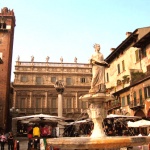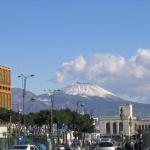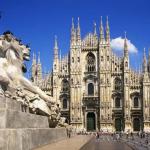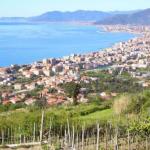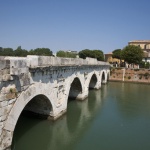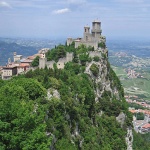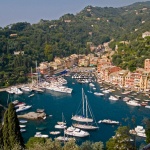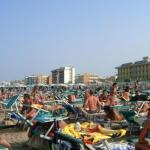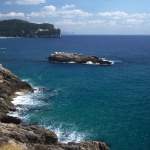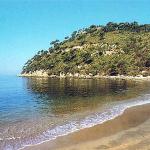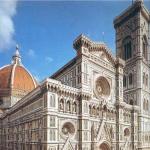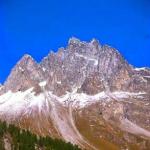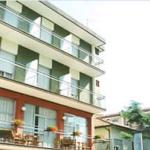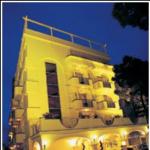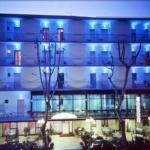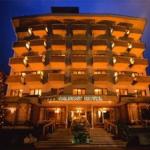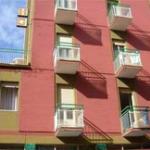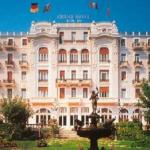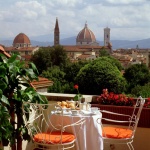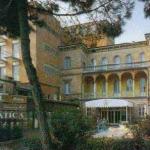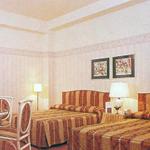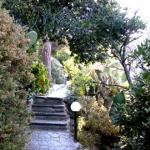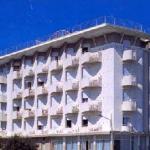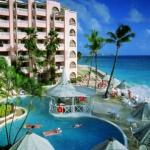Italy Sights
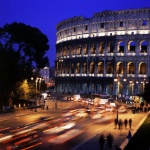 Holidays in Italy - is a constant test of your chustvennosti. Only include the effect of all your senses and mind, you are able to fully experience all the wonders of the famous Italian art and architecture. Here some words is not enough!
Holidays in Italy - is a constant test of your chustvennosti. Only include the effect of all your senses and mind, you are able to fully experience all the wonders of the famous Italian art and architecture. Here some words is not enough!Holidays in Italy - a lesson on how to live correctly. Open fruit and vegetable markets, bakeries and widespread fresh cheese - that's the foundation of Italian life. In this country, dominated by tradition: the neighbors can still be found on the market, to discuss the previous day, laundry still hung out a snow-white linen is dried on the street, like hundreds of years ago, and of course the obligatory passeggiata - a walk before bedtime, preferably with a gelato (ice cream ) in hand. From the foot of the mountains and to the coasts, living emphasis on simple pleasures and high quality.
Colosseum
The most famous ruins in the world, brand of ancient Rome, the Colosseum (Il Colosseo), probably would never have been built, not Decide Vespasian iznichtozhat traces of his predecessor's reign of Nero. Under this program, in place of a pond with swans, adorned Golden Palace, built a grand amphitheater of 70 000 spectators - the largest circus empire. Games in honor of its opening (in 80 AD) have continued unabated 100 days, during which time tore each other and cut 2 000 gladiators and wild beasts 5 000. However, the memory of the emperor-mongers turned out not so easy to erase: officially the new arena was named the Flavian amphitheater, but the stories she has remained as the Colosseum - the name, apparently not referring to her own size, and a colossal (35 meters in height) statue of Nero as a god of the sun.
The current view of the amphitheater - about the triumph of minimalism: strict ellipse, executed three warrants in three tiers, like a calculated form of the arch. But we must understand that brevity - the result of several barbarian invasions, a couple of earthquakes and centuries of legalized plunder: to 1750, when Pope Benedict xiv commanded to finally end the ugliness, the Colosseum, the Romans substituted a stone quarry; of his marbles and travertine blocks built a good part of the city of masterpieces . Initially, the same for each arch was annexed by the statue, and a huge gap between the walls using a special mechanism of delayed canvas. The mechanism of this was extremely difficult - for the management hired a separate team of seamen. But neither the heat of the sun or rain did not become an obstacle for our amusement. Games start early in the morning parade of gladiators. Emperor with the family looked at what is happening with the first row, next arranged senators, Vestal, consuls and priests. Little farther away were the aristocrats and other important citizens. The next series took the middle class, then the marble benches covered galleries were replaced with wooden seats. The top was meant for the plebs and women, the next - for slaves and foreigners.
Pantheon
The surest way to get to the Pantheon, not too long wandering in the lanes - to turn off the Corso of the Palazzo Doria-Pamphili (Palazzo Doria Pamphilj). It is impossible to miss: in the XVII century Genoese Andrea Doria was for his wife, Anna Pamphili, one of the most prominent palaces of Rome, and the current heir - Prince Jonathan, the adopted son of an English nurse, whose hands had died childless, the last descendant of the powerful family - and still owns one of the most impressive art galleries in the city. To get there you can, after a few meters deep into the quarter, on a tiny street with a misleading name Lata ( "wide"). From the corner furtively watching a marble figure with a barrel - The Fountain "water-carrier" (Il Facchino), in whose breasts in papal Rome append topical pamphlets.
The place was marked: in two steps from the fountain in the square College Romano (Piazza del Collegio Romano), was a formidable institution - the main Jesuit school, founded in 1551, less than 20 years after Ignatius of Loyola founded the order. She, in fact, and was called the Roman College (Collegio Romano). Here were tested methods which Jesuit education to the beginning of the XIX century it was considered the best in the Christian world: the rejection of physical punishment, healthcare, encouraging ambition, a focus on understanding rather than memorization of material. Among the graduates of Jesuit colleges were, for example, Moliere, Diderot, Voltaire, Cervantes and Vyazemsky. But despite all the educational achievements, the Jesuits have earned a reputation so odious, that by the XVIII century, any enlightened reformers at the earliest possible beginning of their ban and expel. So a huge complex built in 1582-1584, respectively, immediately after the unification of Italy was selected in favor of the state. Now there is Italian Ministry of Culture - institution, alas, far less meaningful. And once the Jesuits controlled almost the entire region: their first church, Ile-Gesù, located a stone's throw from the Palazzo Pamphili, the second, Sant'Ignazio (Sant Ignazio), adjacent to the northern facade of the former Board. The main thing in it - dome design by Andrea Pozzo (of course, also a Jesuit). From the threshold, he seems very impressive, but it is worth a few steps forward - and found that the ceiling in the church is absolutely flat, but that seemed a dome - just a painting, a clever illusion of what love dabbling in the Baroque era.
The strongest impression of the Pantheon (Pantheon) produces, if we approach him from behind or the side: then, instead of neat, enclosing an art area will see the facade powerful, though rooted in the earth walls, covered with holes and scars. It was here in two thousand years of age this stocky buildings begin to believe.
Roman Forum
The heart of ancient Rome beat here. It chose the consuls, decided the fate of Carthage, passed laws, honored the victors and changed money. Here stood the imperial palaces with marble statues, swimming pools and frescoes. The speakers were gladiators, whose fate is decided by a single motion of the imperial thumb. People strolled in purple togas. It mapped all of the legendary, mythical names, which only appear in books on history: here, please Tarpeian cliff, where the dropping of traitors - it leads to a romantic, planted with oleander Via di Monte Tarpeo.
When the Empire fell, the forums died. Precisely, turned into a vast quarry, where anyone who feels like pulling a building material for palaces, churches and towers. What was left, is gradually disappearing under the ground and overgrown with grass - to the beginning of the Renaissance these places were known only as Campo Vaccino, cow field, the favorite subject of melancholy landscapes. Relic Hunter, which gradually replaced the shepherds have not changed the situation: on the spot cows appeared people with shovels, and only. Life gone away, as if she were not - remains a giant museum, accumulation of debris, mercilessly cut up in Mussolini street-Fori Imperiali. Besides tourists, there are no one - except that pose for? 5 people in costumes gladiators yes hawkers offer disposable camera. At night they disappear - leaving only ruins behind the fence. Leak here at night is almost unreal - all Laz sealed, one can only hope for ceremonial events - literary readings in the Basilica of Maxentius, or any of the three tenors concert in the arena of the Colosseum.
Recently, however, began to struggle with loneliness. In 2002, the whole summer at the Forum allowed for free - you can get past the temple of Vesta, just on the road from the embankment into the store. There is even a chance that the idea persists, the more that the street-Fori Imperiali are going to tame: disinter buried under it built the days of Caesar and display them on public display. How exactly will go to transport - the issue unresolved.
It should immediately notify: Forum (Foro), where the greatest concentration found in the very remnants of ancient Rome, who were here for generations of artists and tourists - the most incoherent sight throughout the city. Walk among the wreckage of columns, stumbling on the pavement and uncomfortable zharyas mercilessly at the sun, if the case, God forbid, happens in summer - exercise is extremely ungrateful. Especially if you are not crammed with Latin-American history from childhood. If anything, the gaps in education can be completed with the help of local guides - old people and enthusiasts, which is ridiculous gestures, will regale you with stories of heroes and traitors antiquity (? 20-30). If a little time, do not despair: to look at the fragments of past grandeur, is sufficient to rise to the Capitol from the streets of San Pietro in Karchere and look down from the observation deck, as far as possible trying to imagine that there is no street-Faurie Imperiali not exist and a medley of marble columns extends continuously up to the wall of Trajan markets. Directly below you will be the most ancient Forum, which usually have in mind when they talk about the Forum (Foro, Foro Romano), but what you see across the road - is Imperial Forums (Fori Imperiali), but once they indeed a single complex.
From the observation platform on Capitol Hill a magnificent view of the Roman Forum. Palace Senators built on a foundation almost entirely destroyed obscherimskogo State Archives Tabularium, enclosing the west side of the ensemble of the Forum.
Milan Attractions
In Milan - Cathedral in the Gothic style, whose construction was started in 1386 and completed in 1965, the Dominican monastery, in the refectory which houses the famous fresco of Leonardo da Vinci's Last Supper, the Brera Art Gallery, several art museums, theater, La Scala.
Sightseeing Venice
In Venice (located on 122 islands, it crosses the 170 channels) - 400 bridges, the most famous, perhaps, is the "Bridge of Sighs," by which the criminals were going after the Doge's court; ST. Mark (828), the Venetian Doge's Palace, granite columns erected in 1180, one of which depicts a winged lion of St.. Mark (the patron saint of Venice), the second - St. Theodore on the crocodile and several art museums.
Florence Attractions
In Florence - Cathedral of Santa Maria del Fiore (1296-1461) in the Gothic style, decorated with red, green and white marble; XIV century bell tower, the Baptistery of San Giovanni (XI-XV centuries), the famous gilded bronze doors, the eastern door decorated with sculpted scenes from the Old Testament, called "Heaven's Gate", the National Museum, which houses a collection of sculptures of Donatello, the fountain of Neptune (1576), the Palazzo Vecchio (1299-1314), Uffizi Gallery - one of the greatest collections of Italian artists, the gallery Pitti with works by Raphael, Perugino, Titian, Tintoretto, the tomb of the Medici family with a marble bas-relief work of Michelangelo, the Medici palace, Ricardo (XV century), which is a museum of the Medici, the monastery of San Marino, in the museum are works by Fra Angelico and Fra Bartolomeo , it is the philosopher of Savonarola's cell, the gallery of the Academy of Fine Arts, which houses the famous sculpture by Michelangelo - David, the Archaeological Museum; Franciscan church of Santa Groche (XIII-XIV century), painted by Giotto, it is called the Pantheon of Florence because it buried Michelangelo Buonarroti, the philosopher and politician, Niccolo Machiavelli, the composer Rossini.
